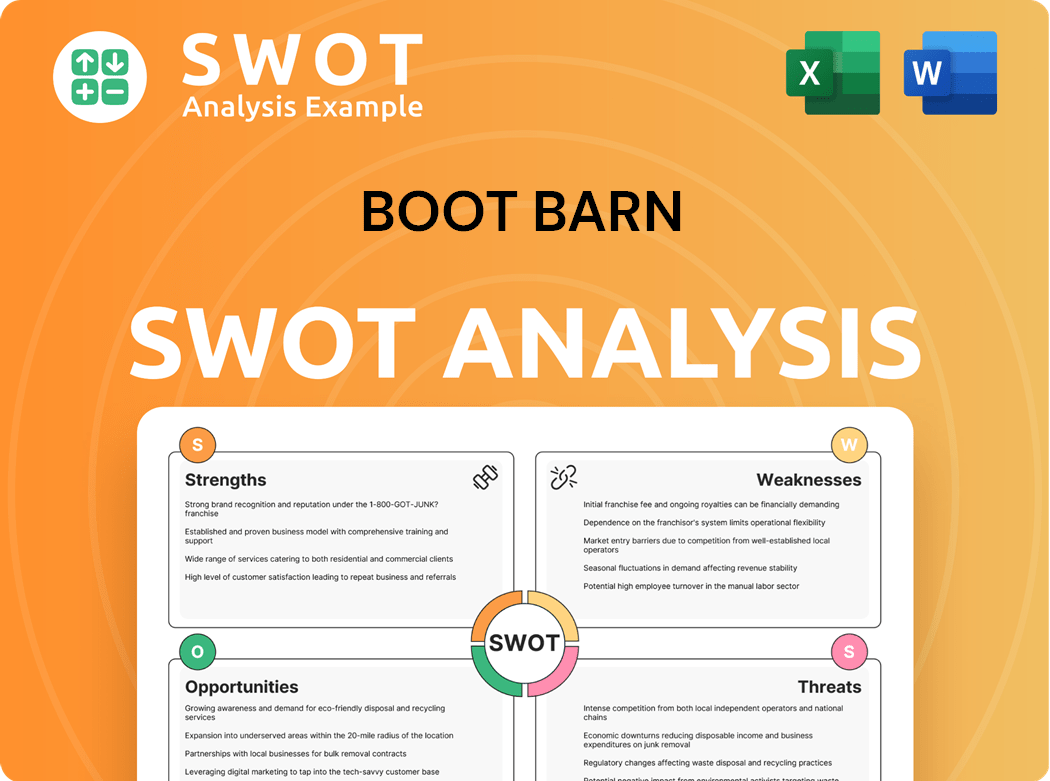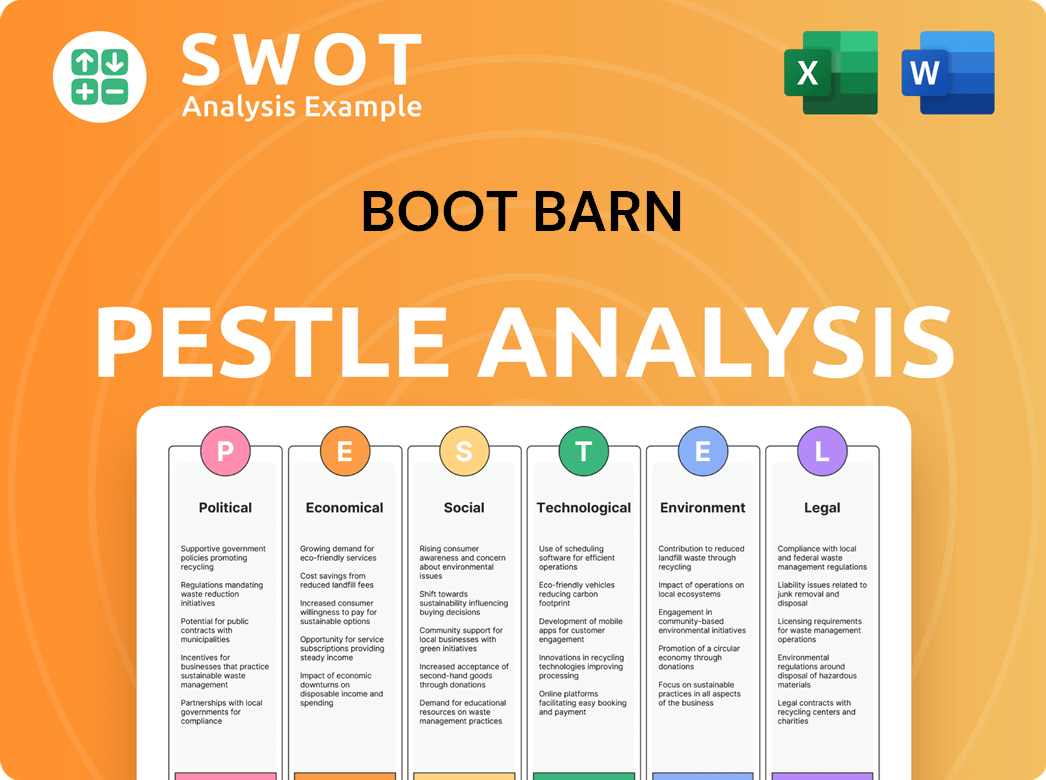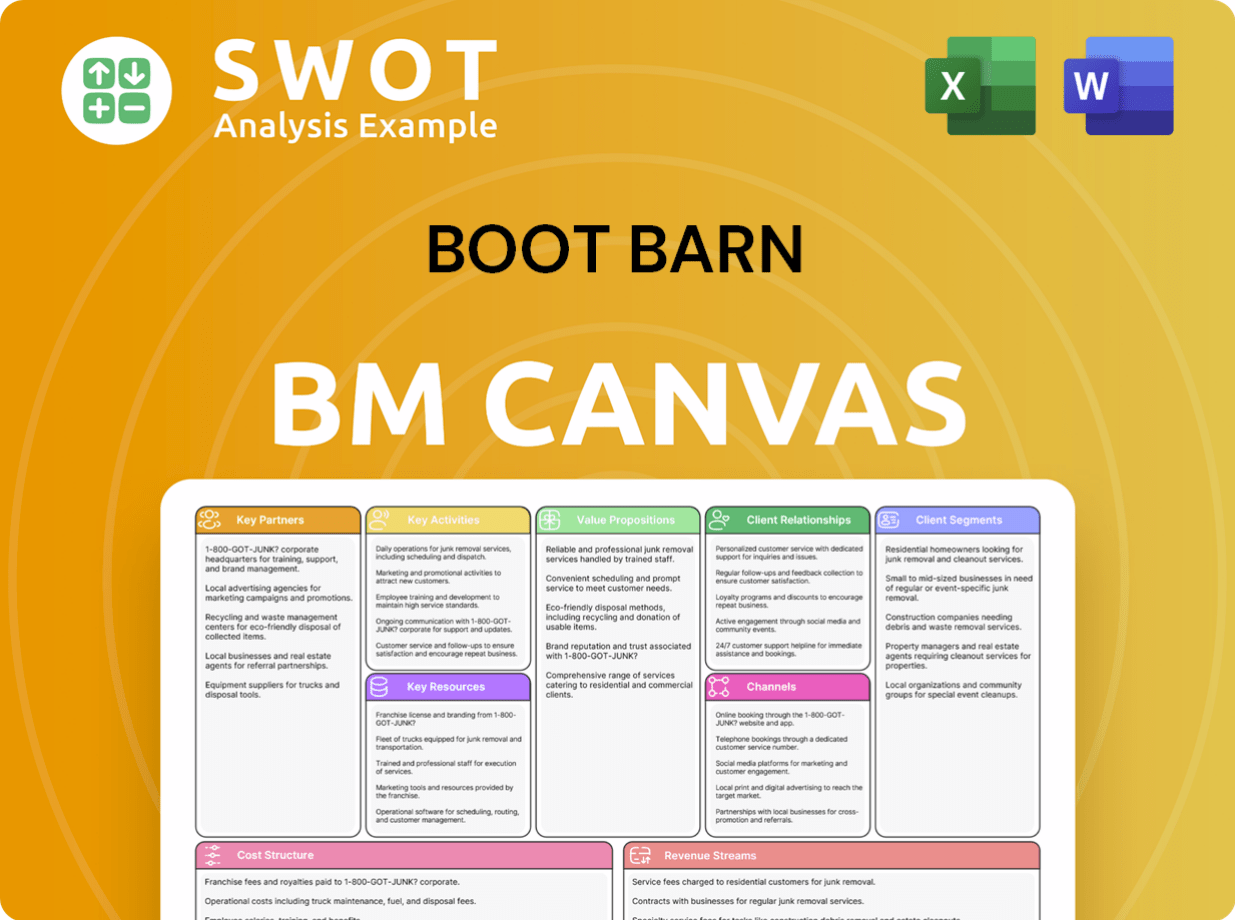Boot Barn Bundle
How Does Boot Barn Thrive in the Retail World?
Boot Barn Company has become a retail powerhouse, dominating the Western wear and workwear markets with impressive financial results and strategic growth. With over 400 stores, Boot Barn caters to a diverse customer base, offering everything from cowboy boots to work boots. Understanding the inner workings of this successful retailer is key to grasping its market influence and investment potential.

Boot Barn's success stems from a unique blend of specialized product offerings and strategic market positioning. This analysis will explore how Boot Barn generates revenue, manages its supply chain, and competes within the dynamic retail landscape. Dive deeper to discover the factors driving Boot Barn's growth and explore the potential of its business model with insights from a comprehensive Boot Barn SWOT Analysis.
What Are the Key Operations Driving Boot Barn’s Success?
The core operations of the Boot Barn Company revolve around providing a curated selection of western and work-related footwear, apparel, and accessories. This strategy caters to a diverse customer base, including ranchers, construction workers, and those embracing the western lifestyle. The company's value proposition centers on offering a wide array of products, from cowboy boots to hats, shirts, and jewelry, creating a one-stop shopping experience for its target demographic.
The company's operational model is built on a multi-channel approach. This approach integrates a network of physical stores with a robust e-commerce platform. This strategy allows customers to shop through various channels, including over 400 physical stores across 47 states and its online platform, bootbarn.com. This blend of physical and digital presence enhances accessibility and convenience for its customers.
The Boot Barn Company's supply chain is a key component of its operations. It sources products from a diverse mix of national brands such as Ariat, Wrangler, and Carhartt, as well as its exclusive brands like Shyanne and Moonshine Spirit. This combination of well-known and proprietary brands enhances its value proposition by offering established quality and unique, trend-driven options. The company's focus on customer service, with knowledgeable staff providing fitting expertise and product guidance, further differentiates it in the market.
The product range includes a wide variety of items such as cowboy boots, work boots, shirts, jackets, hats, belts, and jewelry. The diverse product selection caters to the needs of its target demographic, ensuring that customers can find everything they need for both work and lifestyle purposes.
The company's distribution network is supported by strategically located distribution centers. These centers efficiently manage inventory and fulfill orders for both retail stores and online customers. This system ensures timely delivery and availability of products across all sales channels.
Boot Barn emphasizes customer service, with knowledgeable staff in stores providing fitting expertise and product guidance. This personalized approach enhances the shopping experience and builds customer loyalty. The company focuses on creating a welcoming environment for its customers.
The company's deep understanding of its niche market allows it to offer specialized products that cater specifically to the needs and preferences of its target demographic. This focus translates into benefits such as product authenticity, durability, and a sense of community for its customers. The company is focused on providing high-quality products.
The Boot Barn Company's operations are unique due to its specialized focus on the western and work wear market. This focus allows the company to offer a curated selection of products that meet the specific needs of its customers, differentiating it from general apparel retailers. Its multi-channel approach, combining physical stores with a robust online presence, enhances customer convenience and accessibility.
- Multi-Channel Strategy: Integrating brick-and-mortar stores with a strong e-commerce platform.
- Product Sourcing: Sourcing products from a diverse portfolio of national brands and its exclusive brands.
- Customer Service: Providing knowledgeable staff in stores for fitting expertise and product guidance.
- Distribution Network: Utilizing strategically located distribution centers for efficient inventory management and order fulfillment.
Boot Barn SWOT Analysis
- Complete SWOT Breakdown
- Fully Customizable
- Editable in Excel & Word
- Professional Formatting
- Investor-Ready Format

How Does Boot Barn Make Money?
The primary revenue stream for the Boot Barn Company is the sale of western and work-related footwear, apparel, and accessories. This includes a wide array of products, from cowboy boots and work boots to clothing and accessories. The company's business model is centered on retail sales, utilizing both physical Boot Barn store locations and an e-commerce platform to reach customers.
For the fiscal year 2024, Boot Barn reported net sales of $1.67 billion, demonstrating a 5.6% increase compared to the previous fiscal year. This growth underscores the effectiveness of the company's retail strategy and the demand for its products. The company's monetization strategy involves selling products at a retail markup through its extensive network of physical stores and its e-commerce platform.
Beyond direct product sales, Boot Barn focuses on enhancing customer lifetime value and driving repeat business through loyalty programs and targeted marketing. While specific revenue contributions from loyalty programs or other subtle monetization strategies are not individually quantified as separate streams in public financial reports, their impact is embedded within overall product sales by encouraging customer retention and higher purchase frequencies. The company also leverages its strong brand partnerships with well-known labels to attract customers, and its own exclusive brands contribute to higher margin opportunities. Over time, Boot Barn has expanded its revenue sources by consistently opening new stores, thereby increasing its geographical reach and customer access. In fiscal year 2024, the company opened 52 new stores, further contributing to its revenue growth by expanding its physical footprint.
The company's revenue model is built on several key components, including product sales, customer retention, and strategic expansion. Understanding these elements provides insight into how Boot Barn generates and sustains its financial performance.
- Product Sales: The core revenue stream comes from selling Western wear, work boots, and related items through retail stores and online channels.
- Customer Loyalty: Implementing loyalty programs and targeted marketing efforts to drive repeat business and increase customer lifetime value.
- Brand Partnerships: Leveraging partnerships with well-known brands to attract customers and increase sales.
- Store Expansion: Opening new stores to expand geographical reach and customer access. Learn more about the competitive environment in the Competitors Landscape of Boot Barn.
- Exclusive Brands: Developing and selling its own exclusive brands, which often yield higher profit margins.
Boot Barn PESTLE Analysis
- Covers All 6 PESTLE Categories
- No Research Needed – Save Hours of Work
- Built by Experts, Trusted by Consultants
- Instant Download, Ready to Use
- 100% Editable, Fully Customizable

Which Strategic Decisions Have Shaped Boot Barn’s Business Model?
The evolution of the Boot Barn Company has been marked by strategic growth and adaptation. A key element of its success has been a consistent strategy of expanding its store network. This expansion, combined with investments in its online presence, has allowed Boot Barn to broaden its reach and enhance customer engagement. This approach has been crucial in maintaining its position in the competitive retail landscape.
Operational challenges, such as supply chain disruptions, have been addressed through optimized logistics and strong supplier relationships. The company's ability to navigate these challenges has been vital to maintaining product availability and meeting consumer demand. Furthermore, Boot Barn has focused on curating its product offerings to reflect the evolving preferences in western fashion and workwear, ensuring it remains relevant to its target audience.
The company's competitive advantages are multifaceted, including strong brand recognition and economies of scale. Its curated product assortment, featuring both national brands and exclusive private labels, provides a unique offering that differentiates it from general retailers. The company's commitment to expanding its store count and enhancing its digital capabilities demonstrates its proactive approach to maintaining its competitive edge in a dynamic retail landscape.
In fiscal year 2024, Boot Barn opened 52 new stores, significantly expanding its footprint across the United States. This aggressive expansion strategy is a testament to the company's growth ambitions. The company's focus on strategic store openings has been a cornerstone of its growth.
The company has strategically invested in its e-commerce platform to complement its physical retail locations. This omnichannel approach allows Boot Barn to reach a wider customer base and enhance the overall shopping experience. The integration of online and offline channels has been a key strategic move.
Its strong brand recognition within the western and workwear communities, built over decades, fosters significant customer loyalty. The company also benefits from economies of scale, allowing for competitive pricing and efficient inventory management. The curated product assortment, including both national brands and exclusive private labels, provides a unique offering that differentiates it from general retailers.
In the fiscal year 2024, the company reported net sales of approximately $1.7 billion. This strong financial performance reflects the effectiveness of its strategies. For more details on the company's origins, consider reading this Brief History of Boot Barn.
The company's competitive edge is built upon several key advantages. These include strong brand recognition, a loyal customer base, and efficient inventory management. Furthermore, its curated product assortment caters specifically to the western wear and workwear markets.
- Strong brand recognition in the Western wear and workwear communities.
- Economies of scale leading to competitive pricing.
- A curated product assortment, including national brands and private labels.
- Strategic store expansion combined with a robust e-commerce presence.
Boot Barn Business Model Canvas
- Complete 9-Block Business Model Canvas
- Effortlessly Communicate Your Business Strategy
- Investor-Ready BMC Format
- 100% Editable and Customizable
- Clear and Structured Layout

How Is Boot Barn Positioning Itself for Continued Success?
The Boot Barn Company holds a strong position in the specialized retail market for western and work-related apparel and footwear. With over 400 stores across 47 states and a robust e-commerce presence, it is a significant player in its niche. Its focus on authentic western wear and durable workwear has built a loyal customer base, setting it apart from general apparel retailers.
Key risks include shifts in consumer preferences, economic downturns, competition, and supply chain disruptions. Despite these challenges, the future outlook appears positive, driven by strategic initiatives like store expansion and e-commerce investments. The company's commitment to its core customer base and cautious exploration of new growth avenues are also key factors.
Boot Barn is a leading retailer in the western and work wear market. Its extensive network of stores and online platform gives it a broad reach across the United States. The company's focus on specialized products and a strong brand identity helps it to stand out in the competitive retail landscape.
The company faces risks from changing consumer tastes, economic downturns, and competition from other retailers. Supply chain issues, as seen in recent years, can also affect inventory and product availability. These factors could impact sales and profitability.
Boot Barn plans to open approximately 60 new stores in fiscal year 2025, indicating continued growth. Investments in e-commerce and merchandising are also expected to drive revenue. The company's strategic focus on its core customer base supports its ability to sustain and expand revenue generation.
The company focuses on store expansion, e-commerce investments, and merchandising strategies. These initiatives aim to improve the customer experience and increase sales. The commitment to serving its core customer base while exploring new growth opportunities is also important.
For a deeper understanding of the company's financial performance and ownership structure, you can explore the information available. This includes details on revenue growth, profitability, and the strategic decisions that are shaping the company's future, such as the plans for store openings and e-commerce development. Learn more about the Owners & Shareholders of Boot Barn.
- The company's success is tied to its ability to adapt to changing consumer preferences.
- Boot Barn's expansion plans are a key indicator of its growth strategy.
- Understanding the competitive landscape is crucial for assessing risks.
- The company's online presence is vital for reaching a wider audience.
Boot Barn Porter's Five Forces Analysis
- Covers All 5 Competitive Forces in Detail
- Structured for Consultants, Students, and Founders
- 100% Editable in Microsoft Word & Excel
- Instant Digital Download – Use Immediately
- Compatible with Mac & PC – Fully Unlocked

Related Blogs
- What are Mission Vision & Core Values of Boot Barn Company?
- What is Competitive Landscape of Boot Barn Company?
- What is Growth Strategy and Future Prospects of Boot Barn Company?
- What is Sales and Marketing Strategy of Boot Barn Company?
- What is Brief History of Boot Barn Company?
- Who Owns Boot Barn Company?
- What is Customer Demographics and Target Market of Boot Barn Company?
Disclaimer
All information, articles, and product details provided on this website are for general informational and educational purposes only. We do not claim any ownership over, nor do we intend to infringe upon, any trademarks, copyrights, logos, brand names, or other intellectual property mentioned or depicted on this site. Such intellectual property remains the property of its respective owners, and any references here are made solely for identification or informational purposes, without implying any affiliation, endorsement, or partnership.
We make no representations or warranties, express or implied, regarding the accuracy, completeness, or suitability of any content or products presented. Nothing on this website should be construed as legal, tax, investment, financial, medical, or other professional advice. In addition, no part of this site—including articles or product references—constitutes a solicitation, recommendation, endorsement, advertisement, or offer to buy or sell any securities, franchises, or other financial instruments, particularly in jurisdictions where such activity would be unlawful.
All content is of a general nature and may not address the specific circumstances of any individual or entity. It is not a substitute for professional advice or services. Any actions you take based on the information provided here are strictly at your own risk. You accept full responsibility for any decisions or outcomes arising from your use of this website and agree to release us from any liability in connection with your use of, or reliance upon, the content or products found herein.